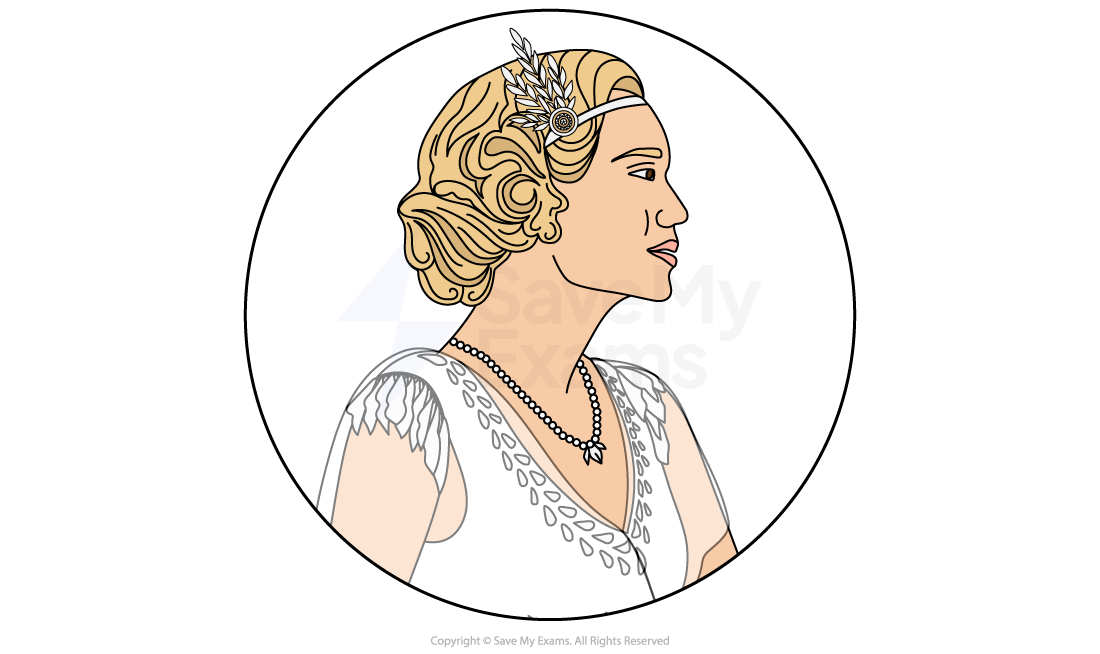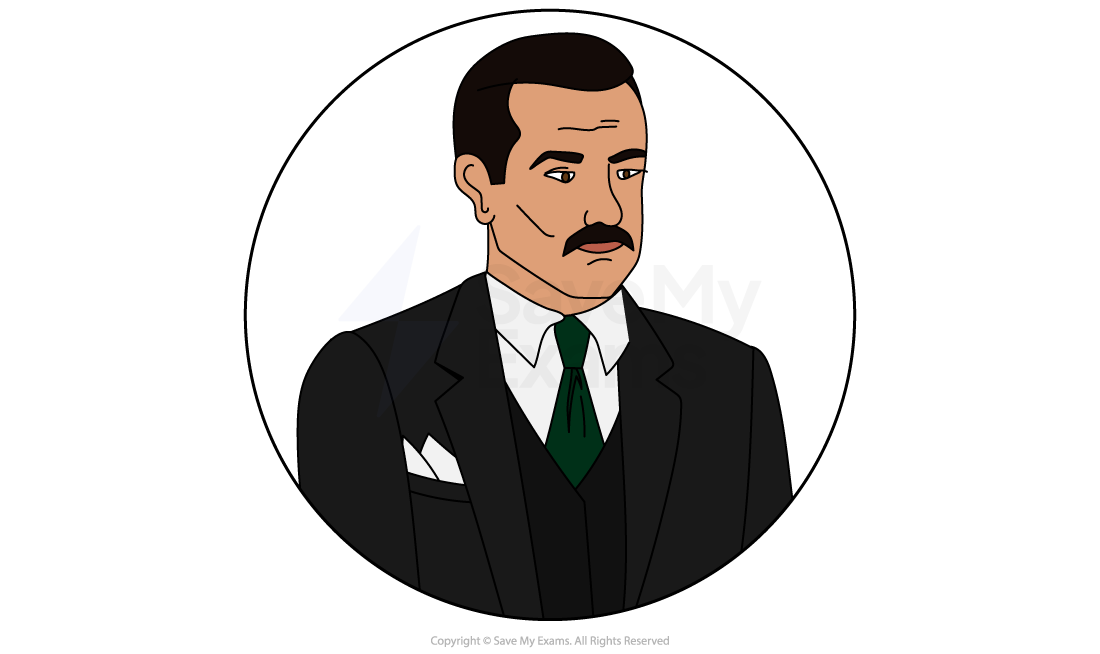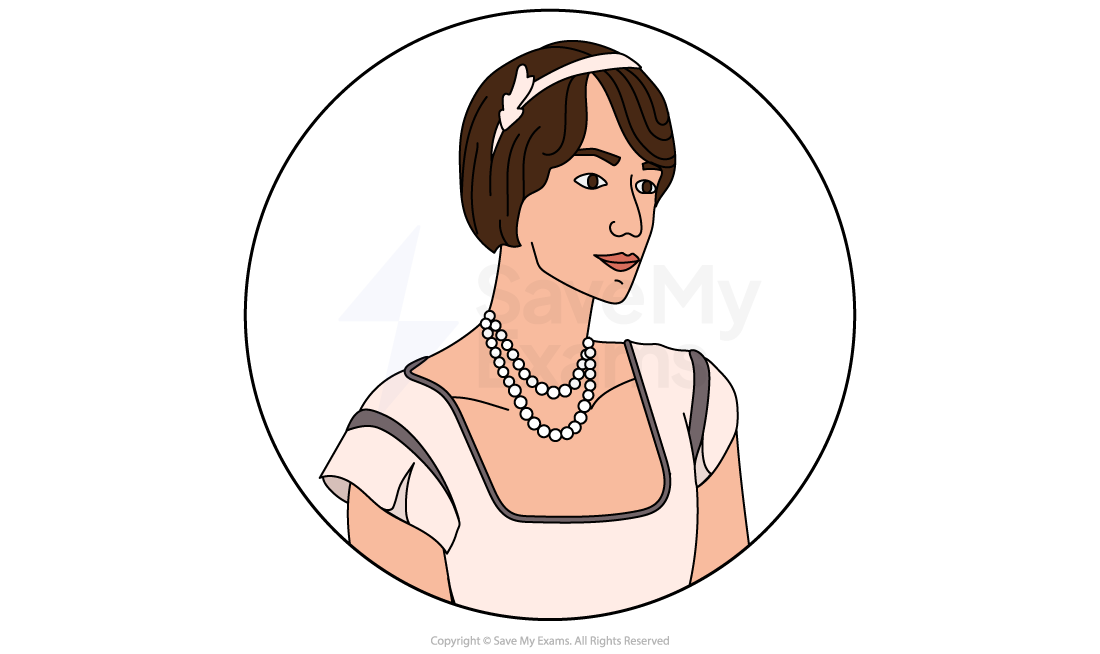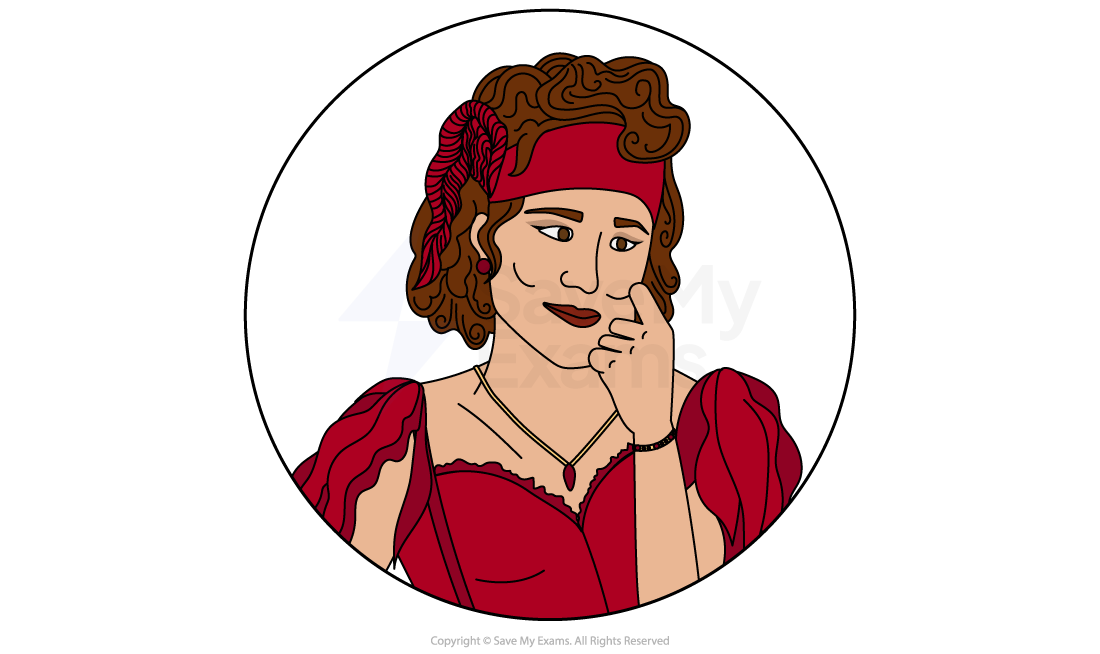The Great Gatsby: Characters (OCR A Level English Literature): Revision Note
Exam code: H472
The Great Gatsby: Characters
The Great Gatsby by F. Scott Fitzgerald features a range of characters whose lives are entwined in the wealthy, glamorous and superficial world of 1920s America. The story is narrated by Nick Carraway, who becomes the neighbour and confidant of the wealthy and mysterious Jay Gatsby. Each character contributes to the novel’s exploration of themes such as the American Dream. Characters can also be symbolic, representing certain ideas or ideals, so it is essential that you consider:
how characters are established
how characters are presented via:
actions and motives
what they say and think
how they interact with others
what others say and think about them
their physical appearance or description
how far the characters conform to or subvert stereotypes
the relationships between characters
what they might represent
Below you will find detailed character profiles for the major characters in The Great Gatsby, along with a summary of the other significant characters.
Main characters
Nick Carraway
Jay Gatsby
Daisy Buchanan
Tom Buchanan
Other characters
Jordan Baker
Myrtle Wilson
George Wilson
Meyer Wolfsheim
Examiner Tips and Tricks
In the exam, the idea of character as a conscious construct should be evident throughout your response. There have been a few different adaptations of the Great Gatsby in film since its publication, but you should try to avoid seeing the original characters as “early versions” of characters that you are familiar with through popular culture.
Instead, focus solely on the text, and your analysis of characters should be literary rather than influenced by other versions or representations.
Nick Carraway

Carraway is the narrator of the novel and provides readers with insight into the lives of the other characters:
He is an observant character who often watches key moments unfold
He moves from the Midwest to New York after graduating from Yale University:
He wishes to pursue a career in finance
His involvement with Gatsby begins when he is invited to Gatsby’s party:
We soon realise that Gatsby has befriended him to get to his cousin, Daisy, whom Gatsby is in love with
Though not nearly as wealthy as the other characters, Carraway becomes Gatsby’s neighbour as he rents a cottage next to his mansion:
He represents the middle classes and serves as a lens through which readers can examine the excesses of the upper class
Carraway forms a unique bond with Gatsby:
While he is critical of Gatsby’s lifestyle and sceptical about the sources of his wealth, he also admires Gatsby’s idealism
Carraway becomes a sympathetic friend to Gatsby, as he begins to understand Gatsby’s longing for the past
While Carraway is the narrator, it is essential to recognise that he is not entirely objective:
His perceptions are influenced by his own biases and experiences, which means that he may not always present events accurately
His perspective gives us an insight into the average American grappling with the complexities of the upper classes in the 1920s
Carraway can be seen as a moral and ethical character in an environment where moral values are eroding:
He is critical of the excesses and moral decay of the wealthy, especially in East and West Egg
Despite his exposure to the extravagant lifestyle to which his acquaintances are accustomed, Carraway maintains a sense of moral integrity:
He becomes disillusioned with the people around him and recognises the emptiness and lack of morality beneath the facade of wealth and status
Jay Gatsby

Gatsby’s character is central to the novel:
His past is shrouded in mystery for most of the novel
He is exceptionally wealthy and hosts extravagant parties at his mansion:
He throws these parties to catch the attention of his love, Daisy Buchanan
Gatsby is deeply in love with Daisy and his entire life revolves around his pursuit of the American Dream and the idealistic rekindling of his past romance with Daisy:
His idealism is evident in his belief that his wealth and success will win back Daisy and help him recreate and rewrite his past with her
Gatsby develops a close friendship with Nick Carraway, confiding in him and trusting him with his secrets:
Carraway becomes both a friend and a confidant, providing a lens through which readers gain insight into Gatsby’s character
Gatsby’s true identity is revealed later in the novel:
We are told that his name was James Gatz and he was born to poor farmers
Gatsby’s wealth is acquired through mysterious and possibly illegal means, with rumours linking him to organised crime:
His friendship with Meyer Wolfsheim is an example of how he may be linked to criminal activity
Despite his wealth and social standing, Gatsby is ultimately a lonely and isolated figure
It appears that his only true goal is to attract Daisy’s attention and win her back
This leaves him detached from everyone else and it is evident that he has no deep connection with anyone
Gatsby exudes confidence and charm:
He can appear composed and self-assured, particularly during his parties
However, his confidence masks his internal insecurities and vulnerabilities
Gatsby’s character follows the classic archetype of the tragic hero, with his fatal flaw being his unrelenting pursuit of an unattainable dream:
His tragic end results from a combination of his own illusions, such as his dream of being with Daisy, and the societal values of an era that is driven by money and extravagance
Gatsby embodies the pursuit of the American Dream, representing the belief that anyone can achieve success and happiness through hard work and determination:
However, through his character, Fitzgerald also critiques the materialism and superficiality associated with that time period
Gatsby is shot by George Wilson, who believes Gatsby was driving the car that killed his wife Myrtle
His death marks the tragic culmination of his unrequited love and failed pursuit of the American Dream
Daisy Buchanan

Daisy Buchanan is the narrator’s cousin and is married to Tom Buchanan, an extremely wealthy man of high social standing
She is described as exceptionally beautiful and charming, embodying the ideal of feminine allure during the Jazz Age:
Her attractiveness captivates both Gatsby and Tom Buchanan
Daisy and Gatsby had a romantic relationship before she married Tom:
Gatsby enlisted as a soldier and it was during this time that she agreed to marry Tom
Despite her clear love for Gatsby, Daisy is unable to break away from the security and social status that she has with Tom
She engages in an affair with Gatsby, but chooses to stay with Tom when confronted:
This emphasises her love for the wealth and security she has with Tom
Daisy is portrayed as shallow and superficial, prioritising wealth and social status over deeper values:
It is evident that her marriage to Tom is largely based on his wealth rather than her love for him
She could be seen as an unattainable character and she becomes a symbol of the unattainable American Dream for Gatsby
Daisy is a mother to a daughter named Pammy, but her role as a mother is portrayed as neglectful and indifferent:
She is more focused on her own desires and social status than on maternal responsibilities
Daisy is emotionally unstable as she is torn between her feelings for Gatsby and her commitment to Tom
Her indecisiveness contributes to the tragic events in the novel, as she cannot choose between Gatsby and Tom
Daisy’s actions, particularly her involvement in the hit-and-run accident that leads to Myrtle Wilson’s death, contribute to the tragic outcome of the novel:
Her lack of accountability and willingness to let Gatsby take the blame underscore her moral ambiguity
Tom Buchanan

Tom Buchanan is born into a wealthy, aristocratic family and it is clear that his wealth and social status shape his worldview and sense of entitlement:
He believes in his inherent superiority due to his wealth and social standing
He looks down on those he considers socially inferior, including Gatsby and the residents of the Valley of Ashes
Tom is physically imposing and athletic, reflecting the idealised masculinity of the time:
His physical strength is used to exert control over others, particularly in confrontations
His aggressive and violent tendencies are evident in his confrontations with characters such as Gatsby and his mistreatment of Myrtle Wilson:
His physical aggression could highlight the toxic masculinity prevalent in the novel
Tom is involved in extramarital affairs, including his relationship with Myrtle Wilson:
His affairs reveal his disregard for traditional moral values and his sense of entitlement to pursue pleasure without consequences
He exerts his control over Daisy, treating her as a possession rather than an equal partner:
His dominance in the marriage reflects the power dynamics prevalent in the upper class during the 1920s
Tom becomes the primary antagonist to Gatsby’s pursuit of Daisy:
He is aware of Gatsby’s love for his wife and actively tries to end the relationship
The conflict between Tom and Gatsby is symbolic of the clash between old money, such as Tom’s, and new money, such as Gatsby’s, in American society
He exhibits a lack of empathy and concern for the well-being of others, particularly those outside his social class:
He is openly racist and expresses prejudiced views, highlighting the racial and social tensions of that time
He also represents the attitudes that were prevalent within his social class during the 1920s
Tom’s flaws are his arrogance and sense of entitlement, which contribute to the tragic events of the novel:
He is the one who tells Wilson that the car that killed his wife was owned by Gatsby
His inability to see beyond his own desires and prejudices leads to Gatsby’s demise and Wilson’s tragic ending
Other characters
Jordan Baker

Jordan is friends with Daisy, and it is through this connection that she becomes acquainted with Nick Carraway and Gatsby
Her friendship with Daisy places her in the social circles of the wealthy in East Egg
Jordan is a professional golfer, known for her skills on the golf course:
Her athletic abilities and success in a conventionally male-dominated sport make her a unique character in the novel
Jordan embodies the “New Woman” of the 1920s, as she is independent, has a career and rejects traditional gender roles
She is presented as a cynical and detached character, often observing events and people with a critical eye
She becomes romantically involved with the narrator, Nick Carraway:
However, their relationship is devoid of any deep emotional connection
This could reflect the superficial nature of the time period and is similar to many of the other relationships in the novel
Myrtle Wilson

Myrtle is Tom Buchanan’s mistress and the affair is a significant subplot in the novel
Her husband, George Wilson, is unaware of the affair until later and does not know who she is having the affair with:
At the end of the novel, he senses her betrayal, which contributes to the tragic end of the novel
Tom uses Myrtle for his own pleasure and to escape the constraints of his marriage:
It is evident that Tom does not have any serious love for her and he views her as a means of fulfilling his desires
The power dynamic in their relationship underscores the inequality and exploitation that is evident in the novel
Her life takes a tragic turn when she is hit and killed by Gatsby’s car, driven by Daisy:
Her death becomes a turning point in the novel, as it leads to a series of tragic events
Myrtle becomes a tragic victim as her desire for a better life leads to her sudden death:
It can be seen as a commentary on the destructive nature of social aspirations
She aspires to climb the social ladder and escape her modest life by associating with the wealthy upper class:
Her affair with Tom is a means of achieving that
It can be inferred that Myrtle is attracted to the materialistic and luxurious world represented by Tom and his wealth
Both Tom and Myrtle are using each other to escape their day-to-day lives
George Wilson
George Wilson is a working-class man who owns a garage in the area, known as the Valley of Ashes
George is married to Myrtle, who is having an affair with Tom Buchanan, and aspires to move up the social ladder:
As a result, their marriage is strained
George is portrayed as a simple and naive character, as he is unaware of the details of his wife’s affair
Goerge becomes a tragic victim of the events in the novel, particularly the affair between Tom and his wife
After the death of his wife Myrtle, George becomes consumed by grief and desperation:
He is determined to find the person responsible for the hit and run, which leads him to Gatsby
In his grief and rage, he fatally shoots Gatsby before taking his own life
George and Gatsby are similar characters as they are both striving for a better life and are victims of social inequalities of the time:
Their parallels highlight the struggles faced by individuals in the novel
His character represents the marginalised and downtrodden in society who are in pursuit of the American Dream
Meyer Wolsheim
Wolfsheim is a business associate and mentor to Gatsby:
He has had significant influence on Gatsby’s life and can be credited for helping to shape Gatsby’s financial success
He is linked to Gatsby’s past and his presence in the novel hints at the illegal and questionable ways through which Gatsby acquired his fortune
It is implied that he is involved in organised crime and illegal activities:
Gatsby hints that he may have fixed the 1919 World Series
Wolfsheim is introduced to the narrator, Nick Carraway, during a lunch with Gatsby
The extent of his influence on Gatsby’s life is not explicitly stated, though it can be inferred that it is significant
Wolfsheim serves as a symbol of the corruption and moral decay associated with wealth in the 1920s:
His character highlights the darker side of the American Dream and the lengths people will go to in order to achieve it
Examiner Tips and Tricks
Remember, in Task 2 you are being assessed on your ability to explore literary texts informed by different interpretations (AO5). This includes considering different interpretations of characters. For example, it may initially appear that Gatsby has achieved the American Dream. He has wealth, power and status. However, is he truly happy? Is the American Dream something that cannot be achieved? An alternative perspective could suggest that he has lost too much of himself and his morals in order to achieve it and, as a result, he is left lonely and morally corrupt. When one considers this perspective, Gatsby has lost more than he has gained.
To find out more about exploring different interpretations, see our Interpretations Revision Notes

Unlock more, it's free!
Did this page help you?